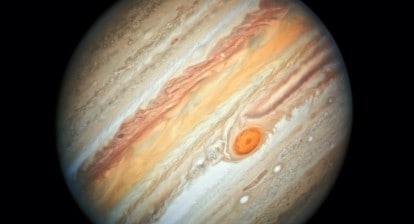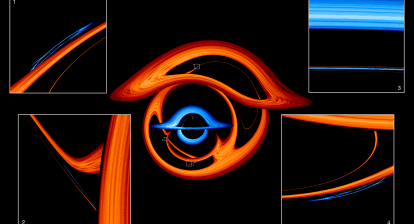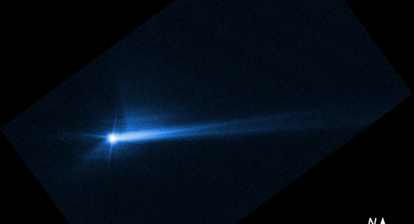Video on the differences between comets, asteroids and meteors
Blogpost/Transcript
October and November are the months for meteor showers and a whole bunch of other night sky phenomena.
But what is the difference between comets, meteors and asteroids? Let’s start with comets, which have enthralled humanity for millennia. In the distant past, they seemed to appear unannounced and were a source of both fear and awe, and which people thought of as “long haired stars”. The word comet itself means long haired star in Greek. Up until the 16th century, their appearance was considered a bad omen, foretelling of disasters, plagues or even death of kings. Chinese astronomers kept very detailed records of comets and they were also recorded in India, where, by the 6th century astronomers knew that they re-appeared periodically. The ancient Babylonians recorded the earliest observations of comets around 3,000 BC.
What are they? Far beyond Neptune, in the vicinity of Pluto, is a disc-like belt of icy bodies, which was first theorized by Gerard Kuiper in 1951. It is known as the Kuiper Belt. These icy bodies are left-overs from the birth of our solar system 4.6 billion years ago and are comprised of ice, coated with organic material. The orbit of Kuiper Belt comets around the sun is around 200 years; they are called short-period comets. There is another section far far away called the Oort Cloud. It surrounds our solar system as a ball of icy-bodies, which are the long-period comets. These Oort Cloud comets can take as long as 30 million years to complete one trip around the Sun but some have shorter periods. Sometimes gravitational disturbances of passing stars and other phenomenon can push them into the inner solar system and we can see them.
How are they different from asteroids? Comets have a frozen nucleus (usually a few kilometres) which contains icy chunks, frozen gases and dust. What makes a comet famous is its tail. During its orbit, when a comet comes closer to the Sun, the ice starts to melt and it develops an atmosphere called a coma. More heat makes the coma bigger — some can extend to hundreds of thousands of kilometres. The pressure of sunlight and solar wind can blow the coma dust and gas away from the Sun, sometimes forming a long, bright tail. Comets actually have two tails―a dust tail and an ion (gas) tail. By the way the tail of a comet always points away from the Sun.
There are 3,661 known comets and some famous ones include Halley’s Comet, which is a short period comet and visits the inner solar system every 75 to 76 years. Halley last appeared in the inner solar system in 1986 and will next appear in mid-2061. It has been observed by ancient civilizations and was not discovered by Edmond Halley. In fact, Halley first determined its periodicity in 1705. Halley’s Comet does not come closer than 89 million kilometres to the Sun, but there are comets out there which crash straight into it, called sun-grazers.
Another famous one is Hale Bopp first observed in 1995 and was visible to the naked eye for 18 months.
A number of spacecraft have been flown by comets. NASA’s Galileo spacecraft observed Comet Shoemaker-Levy 9 breaking apart and crashing into Jupiter in May 1994. The latest mission has been the Rosetta orbiter, which rendezvoused with Comet 67P/Churyumov-Gerasimenko in August 2014 and was the first spacecraft to orbit a comet. In November 2014, a small lander called Philae was released onto the comet’s surface but it was unable to deploy its landing harpoons, so it bounced and landed in an area where it did not receive optimal sunlight to charge its batteries. It did take some amazing images before it died. Rosetta continued to study all aspects of the comet and its environment until mission-end in September 2016.
The other bodies that we periodically see through our telescopes and the potential impacts of which scare us are asteroids.
They are rocky airless bodies, also left over from the early days of the formation of our solar system, 4.6 billion years ago. The current asteroid count according to NASA is 991,988. That means these are only the ones that have been counted. There are probably millions out there.
(Check out Collecting Soil From Asteroids)
Most of this lumpy, potato-shaped rubble is orbiting the Sun between Mars and Jupiter — a region known as the main asteroid belt. They range from largest one, Vesta, which is 530 kilometres (329 miles) in diameter, to those less than 10 meters. Here’s a fun fact, the total mass of all the asteroids combined, is less than that of our Moon. Asteroids, unlike comets, are composed of silicate rock, clay and nickel-iron.
Scientists believe that the asteroid belt had enough material for another planet to form billions of years ago but 4.6 billion years ago, Jupiter traveled to the inner solar system and scattered all the material in its path with its gravitational field. It is because of Jupiter that we have an asteroid belt instead of another planet.
(Check out Jupiter – Solar System’s Giant)
NASA’s Dawn spacecraft, launched in 2007, visited the largest asteroid Vesta in 2011, essentially the first time a spacecraft had orbited a body in the asteroid belt. Latest space missions to asteroids include two current ones that are bringing back soil samples from asteroids Bennu and Ryugu.
There are also asteroids called Trojans, which are a group that share another planet’s orbit around the Sun, such as that of Jupiter. The estimated number of Jupiter Trojans found to date is over 7,000, although scientists think there could be many more. Near-earth asteroids have orbits that pass close by to Earth. Over the history of our planet many have crashed into it as well, some leaving behind gigantic craters. On February 15, 2013, an asteroid entered Earth’s atmosphere over Russia as a fireball and exploded above the city of Chelyabinsk during its passage through the Ural Mountain region. Around 1,500 people were injured, mainly by broken window glass shattered by the shock wave. On August 16, 2020, a tiny Near Earth Asteroid passed by over the Indian Ocean — the closest fly-by on record.
Another fun fact — an asteroid killed the dinosaurs 66 million years ago when it landed underneath the Yucatan Peninsula in Mexico near the town of Chicxulub.
Which brings us to meteors or those flashes of light in the sky commonly known “shooting stars”. Space rocks ranging in size from grains of dust to small asteroids are called meteoroids — a term that only applies when they are in space. Basically, they are pieces of larger bodies that have broken off. Some come from comets, some from asteroids, some even belong to the moon and other planets. They can be rocky or metallic or a combination of the two. When meteoroids enter Earth’s atmosphere at high speed, they burn up and this is what we can see in the night-sky. They are then called meteors. If they survive this trip and fall to the ground, they are called meteorites.
So, what then are meteor showers? They occur when Earth passes through the debris of a comet, or sometimes even an asteroid. Meteor showers are generally named after the constellation from which they seem to originate in the sky. For example, the Perseid meteor shower occurs every August when Earth passes through the debris of Comet Swift-Tuttle, which swings by the Sun every 135 years. Their origin is the Perseus constellation and hence they are called the Perseid meteor shower.
So, to recap: comets are bright and icy with a tail, asteroids are rocky and metallic and kill dinosaurs, and meteors are space trash.
Before we go, let’s talk about Oumuamua, an interstellar object that visited us on October 19, 2017. It was originally thought to be a comet but it did not have any of their characteristics — nor did it seem like an asteroid. It went past the Sun on September 9, 2017, at a speed of 196,000 miles per hour (87.3 kilometres per second). It was confirmed to be an interstellar object from outside our solar system. We do get these at least once a year but they are too faint and hard to spot. As our instruments get more powerful, we can see more of these objects. Oumuamua is cigar-shaped, up to one-quarter mile (400 meters) long and highly-elongated — perhaps ten times as long as it is wide. That aspect ratio is greater than that of any asteroid or comet observed in our solar system to date. Observations suggest that this unusual object had been wandering through the Milky Way, unattached to any star system, for hundreds of millions of years before its chance encounter with our star system.
Here’s hoping there will more such visitors.
Main Music: The Future Ancient Now by Nathan Moore (Youtube Music Archive)
All images Public Domain/ Creative Commons/ NASA/ ESA/ USGS
I hope you enjoy the show. You can subscribe to the You Tube Channel for more on science, history and nature and please do check out the website and follow on social media: Twitter // Instagram // Facebook // Reddit // Threads. You can check out the audio podcast on: Apple Podcasts // Stitcher // TuneIn // Spotify






